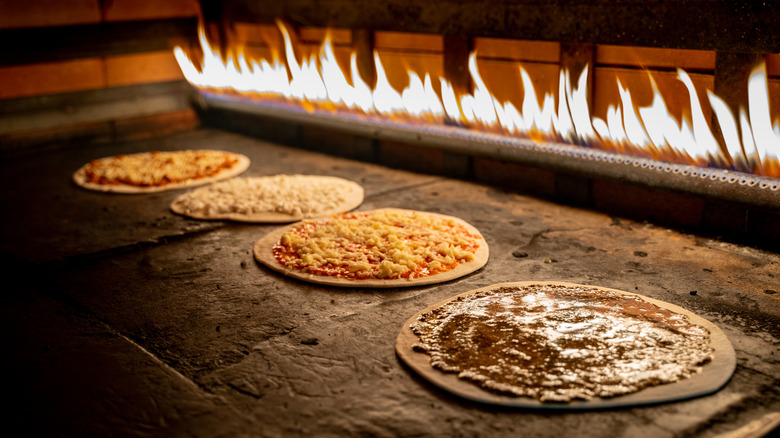Manakish: The Lebanese Flatbread You Need To Try At Least Once
Bread is a universal staple, but despite the similarities in ingredients (usually flour and water), there is a wonderfully remarkable variety of kinds of bread, especially when a subclass like flatbread is involved. While many diners may be familiar with flatbreads from around the world such as tortillas, pita, or naan, there's a Levantine version that you may not have heard of, but that is a must-try: manakish.
Manakish, which is also called manaqish, manaeesh, manakeesh, managish, or man'oushe, is a flatbread usually topped with a variety of ingredients, including spice mixes, cheese, meat, or even yogurt or eggs. Though a relatively new addition to Levantine cuisine (a region of the Middle East that includes Lebanon, Syria, Jordan, Palestine, and Israel), it has become one of the most popular dishes in the area due to its flavor and versatility. You'll find it everywhere from street food stalls to fancy restaurants to special bakeries that specialize in making a wide variety of versions of the flatbread. Because of its universal appeal and the fact that it's a vehicle for an assortment of fixings, it has sometimes been called Lebanese pizza.
Manakish comes with a variety of toppings
Manakish, usually eaten for breakfast or lunch throughout the Levantine region, is a soft bread, which is crispy on the bottom. It is traditionally slathered with za'atar, a spice blend that consists of the titular herb (belonging to the same plant family as thyme, oregano, and marjoram), salt, toasted sesame seeds, and sumac. However, many other toppings are available. Reem Assil, a Palestinian-Syrian chef, told Taste of the flatbread's adaptability, "When people ask me about man'oushe, I always start with the root of that word ... It comes from the Arabic verb naqasha, which is the act of dimpling and shaping the dough. The bread just captures these amazing ingredients ... It's such a versatile flatbread; you can eat it like a pizza, or you can roll it up."
Therefore, there's room for experimentation when making, preparing, and eating traditional manakish — it all depends on the ingredients. For instance, besides za'atar, typical toppings include items like cheese, meats such as ground chicken or lamb, chilies, eggplant, and spinach. The cheese used is most likely one of several varieties of salty white cheese — feta or queso blanco would make good substitutes. The bread is served with labneh, a tangy, creamy strained-yogurt cheese, as well as fresh cucumbers, tomatoes, and onions. Manakish also makes a good companion to dips like tzatziki, hummus, or baba ghanoush. In short, manakish can be anything you can imagine.
How to make manakish
As with most breads, you'll need essential ingredients like water, flour, and yeast, but many Manakish recipes also call for sugar, oil, and salt. Begin by mixing the yeast and sugar with warm water and let it sit till frothy. While you're waiting, blend the dry ingredients in a bowl and create a trench to pour the oil, yeast, and water into, which will then be folded into the rest of the components.
From there, you'll need a clean workspace to knead the dough until it's stretchy and sleek — just a few minutes — before covering it for proofing, much like pizza dough. After the dough has doubled in size, you can portion it into balls. Flatten each section into thin, uniform rounds ready for cooking. The flatbreads are usually about the size of a personal pizza. You can roll them into disks, and then use your fingers to make indentations that will hold the toppings.
A pizza stone or an overturned baking sheet will help to gain that beloved and highly sought-after slightly charred crust associated with flatbreads, but many people bake them on oiled baking sheets or on parchment paper. Before baking, spread the dough with your choice of za'atar, cheese, meat, or all three. The bread is baked at medium-high heat (around 400 – 425 degrees) for 10 to 15 minutes until browned and crispy on the bottom and edges. Serve with your choice of fresh veggies, olives, or dipping sauces.


